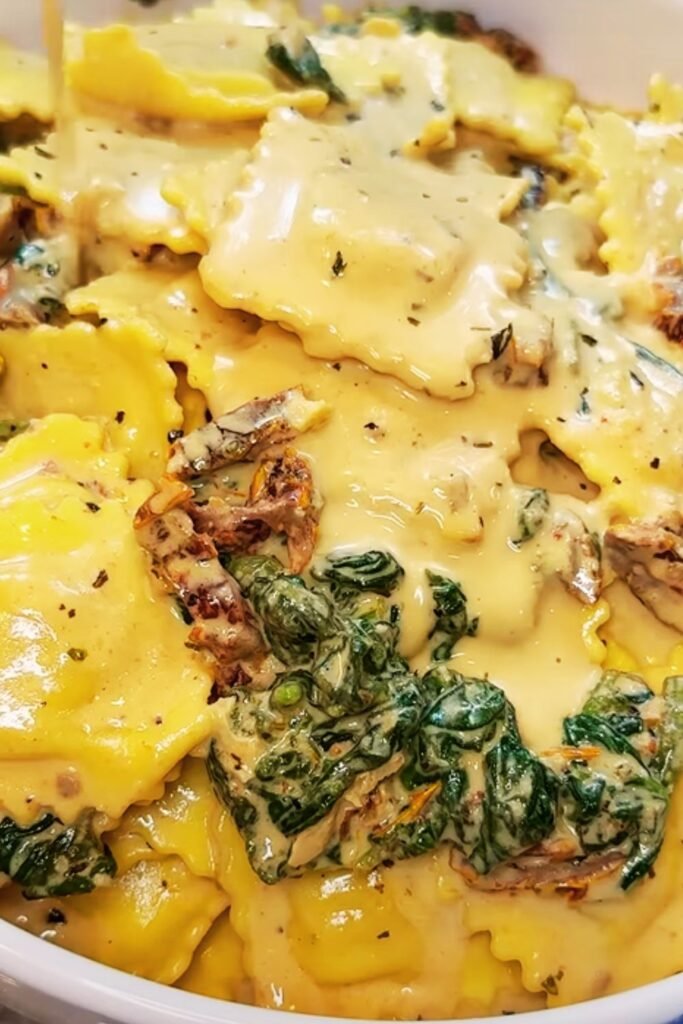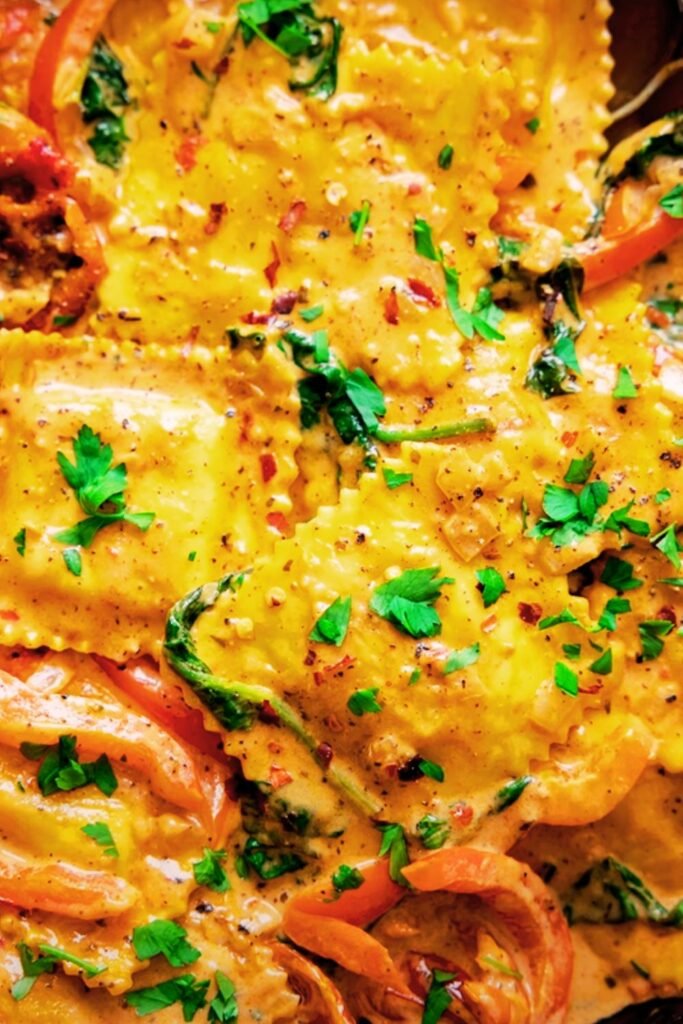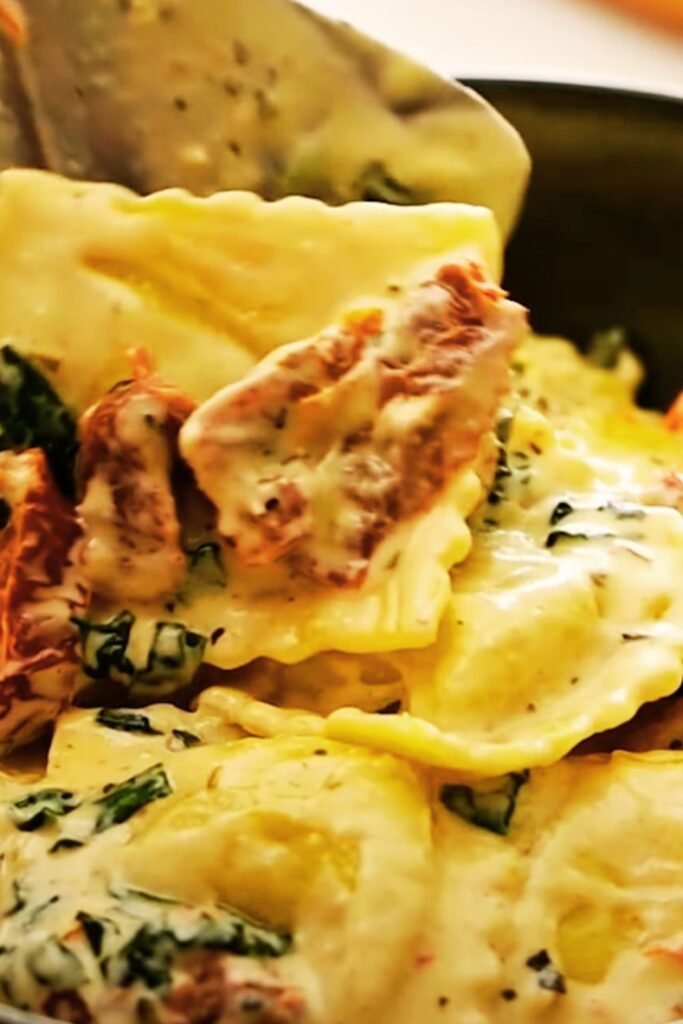When I first tasted Creamy Tuscan Ravioli at a cozy Italian restaurant in Florence, I knew I had discovered something magical. The combination of tender pasta pillows swimming in a rich, herb-infused cream sauce dotted with sun-dried tomatoes and fresh spinach was nothing short of extraordinary. That moment sparked my culinary journey to recreate this masterpiece in my own kitchen, and today I’m thrilled to share everything I’ve learned about perfecting this beloved dish.
The beauty of Creamy Tuscan Ravioli lies in its perfect balance of flavors and textures. Each bite delivers the satisfying richness of cream, the bright acidity of tomatoes, the earthy depth of garlic and herbs, and the delicate pasta that holds it all together. What makes this dish truly special is how it transforms simple, accessible ingredients into something that feels both rustic and refined.
Over the years, I’ve experimented with countless variations, techniques, and ingredient combinations to bring you the most authentic and delicious version possible. Whether you’re planning a romantic dinner for two or hosting a dinner party that will leave your guests raving, this recipe will become your go-to crowd-pleaser.
Understanding the Foundation: What Makes Tuscan Cuisine Special
Tuscan Cooking Philosophy: Simple ingredients prepared with care and respect for their natural flavors
Fresh Herbs: The cornerstone of Tuscan cooking, particularly basil, oregano, and thyme
Quality Olive Oil: Extra virgin olive oil from Tuscany provides the foundation for authentic flavor
Sun-Dried Tomatoes: These concentrated flavor bombs add sweetness and umami depth
Garlic: Used generously but never overpoweringly in traditional Tuscan preparations
The secret to authentic Creamy Tuscan Ravioli isn’t in exotic ingredients or complicated techniques—it’s in understanding how each component contributes to the overall harmony of the dish. When I first started making this recipe, I made the mistake of thinking more ingredients would make it better. I quickly learned that restraint and quality are far more important than complexity.
Essential Ingredients Breakdown
Creating the perfect Creamy Tuscan Ravioli starts with selecting the right ingredients. I’ve spent countless hours testing different brands, types, and preparation methods to bring you this definitive guide.
| Ingredient | Quantity | Quality Tips | Substitution Options |
|---|---|---|---|
| Fresh Ravioli | 1 lb (450g) | Look for pasta with thin walls and generous filling | Frozen ravioli (thaw first), tortellini |
| Heavy Cream | 1 cup (240ml) | 35% fat content for best richness | Half-and-half (thinner sauce) |
| Sun-Dried Tomatoes | 1/2 cup chopped | Oil-packed for better flavor | Fresh cherry tomatoes, roasted red peppers |
| Fresh Spinach | 4 cups packed | Baby spinach works best | Arugula, kale (massage first) |
| Garlic | 4 cloves minced | Fresh only, never pre-minced | Garlic powder (1/2 tsp) |
| Parmesan Cheese | 1/2 cup grated | Parmigiano-Reggiano preferred | Pecorino Romano, Grana Padano |
| Fresh Basil | 1/4 cup chopped | Bright green leaves only | Dried basil (1 tbsp) |
| Extra Virgin Olive Oil | 3 tablespoons | Cold-pressed, fruity variety | Regular olive oil |
| Chicken Broth | 1/2 cup | Low-sodium preferred | Vegetable broth, white wine |
| Salt | To taste | Sea salt or kosher salt | Table salt (use less) |
| Black Pepper | 1/2 teaspoon | Freshly ground | Pre-ground pepper |
The quality of your ravioli makes an enormous difference in the final dish. I always recommend visiting a local Italian deli or specialty store for fresh, handmade ravioli when possible. The thin pasta walls allow the filling to shine while the cream sauce doesn’t overpower the delicate flavors inside.
Step-by-Step Cooking Process
My method for making Creamy Tuscan Ravioli has been refined through hundreds of attempts, and I’m confident this approach will give you restaurant-quality results every single time.
Preparation Phase (10 minutes)
- Bring a large pot of salted water to boil – I use about 1 tablespoon of salt per quart of water
- Prepare all ingredients – Mince garlic, chop sun-dried tomatoes, wash and dry spinach
- Grate Parmesan cheese fresh – Pre-grated cheese doesn’t melt as smoothly
- Set up your cooking station – Have everything within arm’s reach for smooth cooking
Cooking the Perfect Ravioli (3-5 minutes)
The most critical aspect of this dish is perfectly cooked ravioli. Overcooked pasta will fall apart in the cream sauce, while undercooked ravioli won’t absorb the flavors properly.
- Add ravioli to boiling water – Don’t overcrowd; cook in batches if necessary
- Cook until they float – Fresh ravioli typically takes 3-4 minutes
- Test for doneness – The pasta should be tender but still have a slight bite
- Reserve pasta water – Save 1 cup before draining for sauce adjustment

Creating the Cream Sauce (8-10 minutes)
This is where the magic happens. The key to a silky, restaurant-quality cream sauce lies in controlling the heat and building layers of flavor.
- Heat olive oil in a large skillet over medium heat
- Add minced garlic – Cook for 30 seconds until fragrant, not browned
- Add sun-dried tomatoes – Sauté for 1 minute to release their oils
- Pour in chicken broth – Let it reduce by half, about 2 minutes
- Add heavy cream – Bring to a gentle simmer, never a rolling boil
- Season with salt and pepper – Taste and adjust as needed
- Add fresh spinach – Stir until just wilted, about 1 minute
- Incorporate Parmesan cheese – Add gradually while stirring to prevent clumping
Bringing It All Together (2-3 minutes)
- Add cooked ravioli to the sauce – Use a slotted spoon to transfer gently
- Toss carefully – Coat each piece without breaking the pasta
- Add pasta water if needed – For desired sauce consistency
- Finish with fresh basil – Stir in just before serving
- Taste and adjust seasoning – Final salt and pepper check
Mastering the Cream Sauce: Professional Tips
After years of perfecting this recipe, I’ve learned that the cream sauce is where most home cooks struggle. Here are my hard-earned secrets for success:
Temperature Control: Never let the cream boil vigorously. High heat will cause the cream to break and become grainy. I keep my heat at medium-low once the cream is added.
Timing: Add ingredients in the correct order. Garlic first to bloom its flavor, then tomatoes to release their oils, broth to build depth, and cream to create richness.
Consistency: The sauce should coat the back of a spoon but not be thick like Alfredo. If it’s too thick, add reserved pasta water one tablespoon at a time.
Cheese Integration: Add Parmesan off the heat or on very low heat to prevent seizing. Stir constantly and add gradually.

Nutritional Information and Health Considerations
Understanding the nutritional profile of Creamy Tuscan Ravioli helps you enjoy this indulgent dish as part of a balanced diet.
| Nutrient | Per Serving (1/4 recipe) | Daily Value % |
|---|---|---|
| Calories | 485 | 24% |
| Total Fat | 28g | 36% |
| Saturated Fat | 16g | 80% |
| Cholesterol | 95mg | 32% |
| Sodium | 680mg | 30% |
| Total Carbohydrates | 42g | 15% |
| Dietary Fiber | 3g | 11% |
| Protein | 18g | 36% |
| Calcium | 285mg | 22% |
| Iron | 2.8mg | 16% |
| Vitamin A | 2850 IU | 57% |
| Vitamin C | 12mg | 13% |
Making It Healthier
While this is inherently a rich dish, I’ve discovered several ways to lighten it without sacrificing flavor:
- Substitute half-and-half for heavy cream – Reduces calories by about 100 per serving
- Use whole wheat ravioli – Adds fiber and nutrients
- Increase spinach quantity – More vegetables, same great taste
- Reduce Parmesan – The dish is still delicious with less cheese
- Add grilled chicken or shrimp – Boosts protein content
Variations and Adaptations
One of the things I love most about this recipe is its versatility. Over the years, I’ve created numerous variations that cater to different tastes and dietary needs.
Protein Additions
Grilled Chicken Tuscan Ravioli: Add 2 cups of diced, cooked chicken breast during the last 2 minutes of cooking. The chicken adds substantial protein and makes this a complete meal.
Shrimp Tuscan Ravioli: Sauté 1 pound of large shrimp with the garlic, then remove and add back at the end. The seafood version feels more elegant and cooks quickly.
Italian Sausage Variation: Brown 1/2 pound of Italian sausage before starting the sauce, then proceed with the recipe. This creates a heartier, more rustic dish.
Vegetable Variations
Mushroom Tuscan Ravioli: Add 8 ounces of sliced mushrooms with the sun-dried tomatoes. The earthy flavor complements the cream beautifully.
Roasted Red Pepper Version: Substitute roasted red peppers for sun-dried tomatoes for a sweeter, smokier flavor profile.
Artichoke Addition: Include 1 cup of marinated artichoke hearts for a tangy Mediterranean twist.
Dietary Adaptations
Dairy-Free Version: Use coconut cream and nutritional yeast instead of dairy cream and Parmesan. The result is surprisingly delicious and creamy.
Gluten-Free Option: Substitute gluten-free ravioli, available at most grocery stores. The cooking time may vary slightly.
Lighter Version: Use Greek yogurt mixed with a little milk instead of heavy cream. Add it off heat to prevent curdling.
Storage and Reheating Guidelines
Proper storage ensures you can enjoy leftovers without compromising quality. Here’s what I’ve learned through experience:
| Storage Method | Duration | Quality Notes |
|---|---|---|
| Refrigerator | 3-4 days | Store in airtight container |
| Freezer | 2-3 months | Sauce may separate slightly |
| Room Temperature | 2 hours maximum | Food safety concern beyond this |
Reheating Techniques
Stovetop Method (Recommended): Heat gently in a skillet over low heat, adding a splash of milk or broth to restore creaminess. This takes 5-7 minutes but gives the best results.
Microwave Method: Use 50% power in 30-second intervals, stirring between each. Add liquid as needed to prevent drying out.
Oven Method: Cover with foil and heat at 350°F for 15-20 minutes. Add a little broth before reheating to maintain moisture.
Serving Suggestions and Pairings
The beauty of Creamy Tuscan Ravioli lies in its versatility as both a standalone dish and part of a larger Italian feast.
Perfect Side Dishes
Garlic Bread: The classic pairing that never fails. I make mine with a mixture of butter, minced garlic, and fresh herbs.
Caesar Salad: The crisp lettuce and tangy dressing provide a perfect contrast to the rich pasta.
Roasted Vegetables: Zucchini, bell peppers, and eggplant roasted with olive oil and herbs complement the Tuscan flavors.
Antipasto Platter: Olives, cured meats, and cheeses create an authentic Italian dining experience.
Beverage Pairings
Sparkling Water with Lemon: The effervescence cleanses the palate between bites.
Italian Sparkling Fruit Juices: Aranciata or limonata provide sweetness without overwhelming the dish.
Fresh Herb Teas: Basil or mint tea offers a refreshing finish to the meal.
Coffee: A small cup of espresso after the meal follows Italian tradition perfectly.

Common Mistakes and Solutions
Through my years of making and teaching this recipe, I’ve identified the most frequent pitfalls and their solutions:
Sauce Problems
Broken Cream Sauce: Usually caused by too high heat or adding cold ingredients to hot cream. Solution: Remove from heat, whisk in a tablespoon of cold cream.
Too Thick Sauce: Add reserved pasta water one tablespoon at a time until desired consistency is reached.
Too Thin Sauce: Simmer gently to reduce, or create a slurry with cornstarch and water.
Grainy Cheese: Parmesan added too quickly or at too high heat. Remove from heat and whisk vigorously.
Pasta Issues
Overcooked Ravioli: They fall apart in the sauce. Prevention is key—test frequently while cooking.
Undercooked Ravioli: Hard centers that don’t absorb flavors. Add a minute or two to cooking time.
Ravioli Sticking Together: Use plenty of water and stir gently after adding to pot.
Expert Tips for Restaurant-Quality Results
These professional techniques will elevate your Creamy Tuscan Ravioli from good to extraordinary:
- Salt Your Pasta Water Properly: It should taste like seawater. This is your only chance to season the pasta itself.
- Save Pasta Water: The starchy water is liquid gold for adjusting sauce consistency and helping it cling to the pasta.
- Finish Cooking in the Sauce: Let the ravioli spend the last minute cooking in the cream sauce to absorb flavors.
- Use Room Temperature Cream: Cold cream can shock the sauce and cause breaking.
- Fresh Herbs at the End: Add basil just before serving to maintain its bright color and fresh flavor.
- Warm Your Serving Plates: This keeps the dish at the perfect temperature longer.
- Don’t Overcrowd the Pan: Cook in batches if necessary to maintain proper heat distribution.
Seasonal Adaptations
I love adapting this recipe to showcase seasonal ingredients throughout the year:
Spring Version
Add fresh peas and asparagus tips for a bright, green variation that celebrates spring vegetables.
Summer Adaptation
Include fresh cherry tomatoes and basil from the garden, reducing the sun-dried tomatoes slightly.
Fall Variation
Incorporate roasted butternut squash and sage for an autumn-inspired twist.
Winter Comfort
Add extra garlic and herbs, perhaps some roasted root vegetables, for a warming winter meal.
Questions and Answers
Q: Can I make this dish ahead of time? I don’t recommend making the complete dish ahead, as the pasta can become mushy and the cream sauce may separate. However, you can prepare the cream sauce base (without the cream) up to a day ahead and finish it when ready to serve.
Q: What’s the best type of ravioli filling for this recipe? Cheese ravioli works beautifully, particularly ricotta and spinach or four-cheese varieties. The mild flavors complement rather than compete with the cream sauce. I avoid heavily seasoned or meat-filled ravioli as they can overpower the delicate Tuscan flavors.
Q: How do I prevent the cream sauce from breaking? Keep the heat at medium-low once you add the cream, never let it boil vigorously, and add the Parmesan cheese gradually while stirring constantly. If it does break, remove from heat immediately and whisk in a tablespoon of cold cream.
Q: Can I use frozen ravioli for this recipe? Absolutely! Frozen ravioli actually works quite well. Don’t thaw them first—just add an extra minute or two to the cooking time. Fresh ravioli will give you the best texture, but frozen is a convenient and delicious alternative.
Q: How can I make this dish vegetarian? The recipe as written is already vegetarian! Just make sure to use vegetable broth instead of chicken broth. For a vegan version, substitute coconut cream for heavy cream and nutritional yeast for Parmesan cheese.
Q: What should I do if my sauce is too salty? Add a splash of heavy cream or milk to dilute the saltiness, or include a bit of sugar to balance the flavors. You can also add more pasta or vegetables to stretch the dish and reduce the salt concentration.
Q: Can I add protein to this dish? Definitely! Grilled chicken, sautéed shrimp, or Italian sausage all work wonderfully. Cook the protein separately and add it during the last few minutes to heat through without overcooking.
Q: How long does this dish keep in the refrigerator? Leftover Creamy Tuscan Ravioli will keep for 3-4 days in the refrigerator when stored in an airtight container. The texture is best when reheated gently on the stovetop with a splash of milk or broth to restore the creamy consistency.
Q: Why is my cream sauce not creamy enough? This usually happens when the sauce is too hot or hasn’t been stirred enough. Make sure to use heavy cream (not milk or half-and-half unless intentionally making a lighter version), and stir constantly when adding the Parmesan cheese.
Q: Can I substitute the sun-dried tomatoes? Yes! Roasted red peppers, fresh cherry tomatoes (halved and sautéed), or even marinated artichoke hearts make excellent substitutions. Each will give the dish a slightly different flavor profile while maintaining that essential Mediterranean character.
This Creamy Tuscan Ravioli recipe has become one of my most treasured dishes, one that never fails to impress whether I’m cooking for family on a weeknight or entertaining guests for a special occasion. The combination of simple techniques, quality ingredients, and careful attention to detail creates something truly magical—a dish that transports you straight to the heart of Tuscany with every single bite.
The key to mastering this recipe lies in understanding that great Italian cooking isn’t about complexity; it’s about respecting each ingredient and allowing their natural flavors to shine. When you take the time to properly prepare each component and bring them together with care and attention, the result is nothing short of extraordinary.
Remember, cooking is a journey of discovery and personal expression. Use this recipe as your foundation, but don’t be afraid to make it your own. Add your favorite vegetables, adjust the seasonings to your taste, or experiment with different herbs and spices. The most important ingredient in any dish is the love and passion you bring to the kitchen.